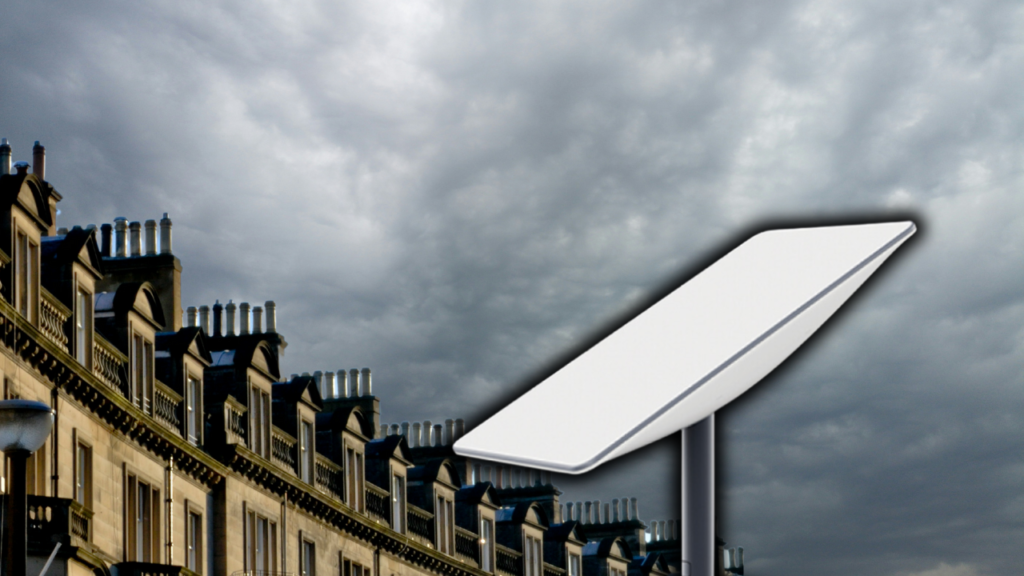One of the UK’s first AUTHORIZED STARLINK™ INSTALLERS.

Starlink recently increased its total launched satellite count to 5872, successfully deploying Group 7-17, which contained 22 satellites. Accounting for the failure or deorbiting of somewhere in the region of 430 Starlink satellites, that leaves more than 5400 satellites currently in orbit. (Read more Starlink Statistics here)
Starlink, a satellite internet constellation developed by SpaceX, exists to bring cheap satellite-based internet to regions that either lack service or where traditional internet is overpriced. Therefore, Starlink offers a viable alternative to wired networks and gives users more choices.
However, potential users often ask, “Does cloud cover affect Starlink?” Understanding the implications of weather on this innovative technology is crucial for those relying on consistent internet access.
TLDR:
In general, it’s rare for cloud cover alone to significantly impact Starlink’s connectivity, however, like with traditional internet and most other things, adverse weather conditions can cause temporary disruptions in your connectivity.
Before delving into the specifics of cloud cover’s impact on Starlink, it’s important first to grasp how satellite internet operates. Unlike traditional internet services, typically provided by telephone wire or cable, satellite internet communicates with orbiting satellites to provide internet connectivity using a satellite dish and router. Let’s look at potential scenarios where weather can diminish the performance of a Starlink setup and answer the question, does cloud cover affect Starlink?
Naturally, anyone planning to invest in a new system wants to ensure they receive a reliable service and steady internet performance. Given that there are no wired connections to the internet, potential Starlink users may worry that unpredictable weather might result in stress-inducing, unpredictable internet.
It’s true that older satellite internet can be susceptible to weather conditions, including heavy rain, snow, and, yes, cloud cover. These elements can temporarily weaken the signal strength, leading to connectivity issues on previous incarnations of satellite internet. However, Starlink has been designed with advanced technology to mitigate these effects as much as possible.
>> Read More: Starlink UK Price Guide
So, does cloud cover affect Starlink? The satellites utilise a range of frequencies, including the Ka (12GHz to 18Ghz) and Ku bands (26.5 GHz to 40GHz), to communicate with ground stations and user terminals. Generally, it’s rare for cloud cover alone to significantly impact Starlink’s connectivity.
The system is engineered to ensure robust performance even in adverse weather conditions. Users might notice slight decreases in speed or brief interruptions during heavy storms, as the signal strength diminishes as it passes through moisture-laden clouds, but these occurrences are not common. Regardless, even when affected, the outcome is a slight slowing of internet speed, not an outright disruption that prevents usage.
It’s worth noting that the weather can often disrupt traditional internet access. Although uncommon, heavy downpours can flood street cabinets, causing disruption that can last from minutes to days, depending on the severity, and falling trees can break telephone wires that bring the internet to outlying rural areas.
Starlink requires a direct line of sight of the satellites in orbit to operate. As anyone who has experienced heavy snow knows, snow and ice can begin to build up on any surface. Thankfully, though, Starlink dishes were designed to handle this problem. They can detect snow and will respond by warming up enough to melt the snow and make it slide off. However, what it can’t fix for itself is the build-up of snow on surrounding surfaces that may obstruct the necessary view of the sky. Owners can remedy this, of course, by simply brushing away any snow that is causing obstructions.
Every dish comes with Starlink lightning protection and is ready for installation. As long as this protection is correctly set up, it is unlikely that your Starlink satellite dish will be impacted by lightning. However there have been some cases of Starlink hardware being impacted by lightning and in those cases, Starlink themselves have often replaced the customer’s dish, free of charge.
Discussing Starlink’s susceptibility to weather, including cloud cover, introduces the concept of trade-offs. Yes, like all satellite internet services, Starlink faces challenges that terrestrial broadband options typically do not. However, these trade-offs come with considerable benefits.
Starlink offers high-speed internet access in locations where traditional broadband services are unavailable or unreliable. This advantage is a game-changer for people in rural or remote areas, providing them with opportunities for education, business, and communication that were previously out of reach.
SpaceX continues to expand the Starlink constellation, aiming to improve coverage, speed, and reliability. Each new satellite launched into orbit enhances the network’s resilience against adverse weather conditions, making the service more robust and dependable.
>> Read more: Is Starlink Worth It?
Starlink and its users are not entirely at the mercy of the weather. There are strategies to mitigate the impact of cloud cover and other adverse conditions:
Despite the rare hiccups caused by severe weather, Starlink represents a monumental leap forward in internet technology. Its ability to provide high-speed, reliable internet service to the most remote corners of the globe is unparalleled. As the system evolves, improvements in weather resilience are expected, further solidifying Starlink’s position as a viable internet solution for users worldwide.
Starlink’s commitment to bridging the digital divide cannot be understated. The service’s expansion into developing countries and remote regions is providing essential internet access to communities that traditional internet service providers have left behind. This access opens doors to educational resources, economic opportunities, and global connectivity that were previously unimaginable.
To answer the initial query, “Does cloud cover affect Starlink / Does Bad Weather Affect Starlink?”—it’s possible, but the impact is generally minimal and infrequent. While the worst weather scenarios, including heavy cloud cover, can pose challenges to satellite internet services like Starlink, the advantages far outweigh these occasional inconveniences. The trade-off of having reliable, high-speed internet in the most remote areas is a testament to the revolutionary potential of Starlink.
As we move forward, the continuous improvements in satellite technology and infrastructure promise to further minimise the impact of adverse weather conditions. Starlink’s journey represents not just technological advancement but a commitment to global connectivity, making the world a smaller, more accessible place for everyone.

Let's get you online!
Fill in your details and we'll be in touch shortly.

Please fill in your details
Head Office:
11 Old Steine, Brighton, BN1 1EJ

© 2025 All Rights Reserved.